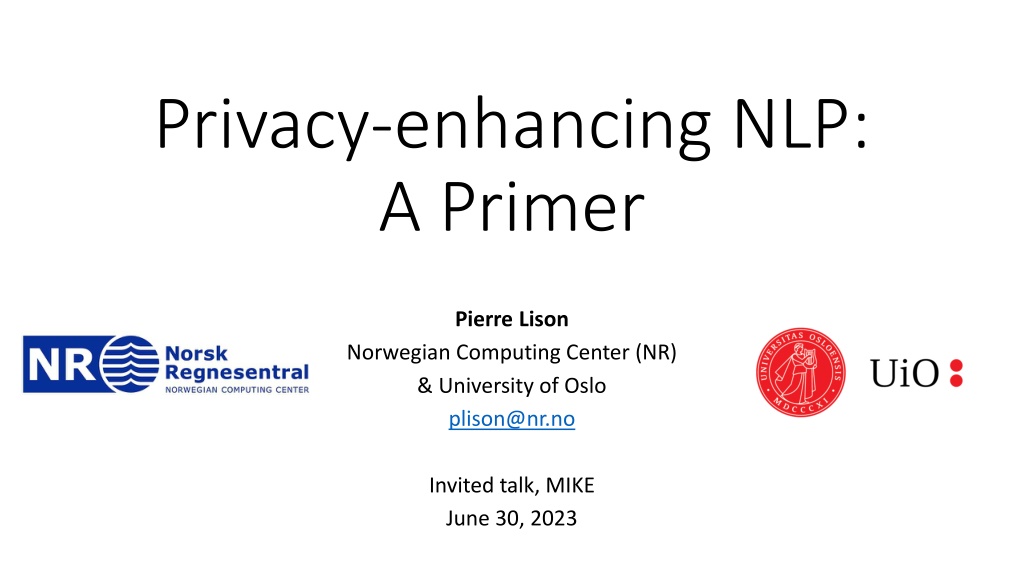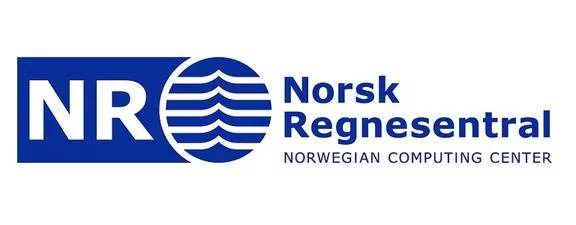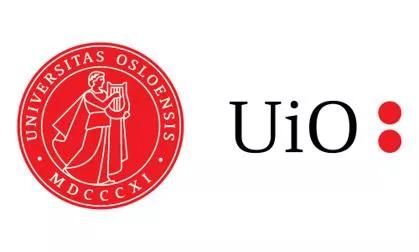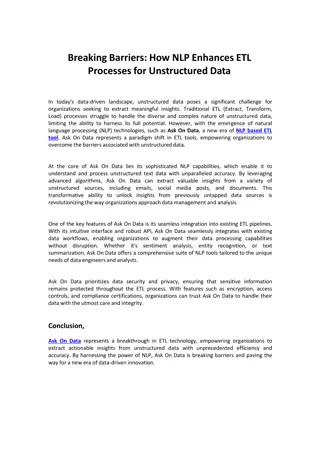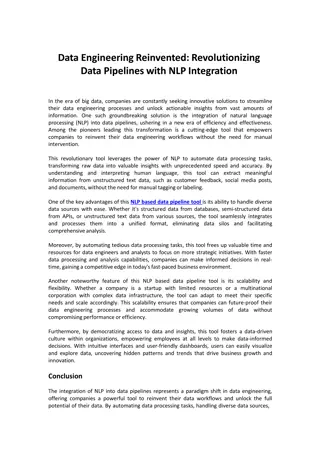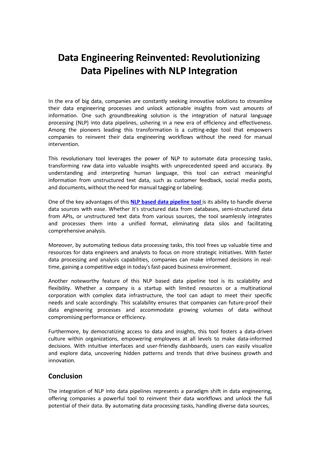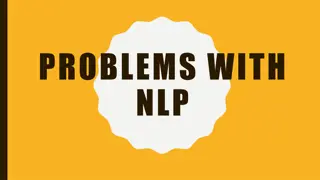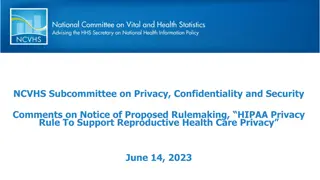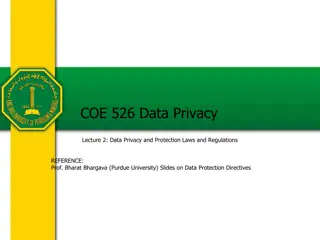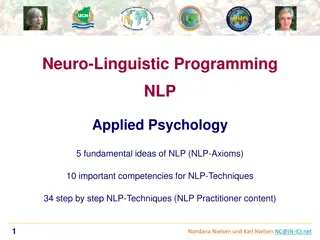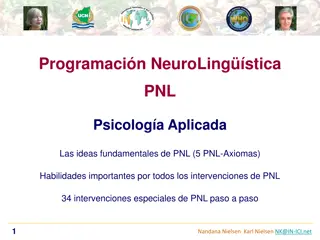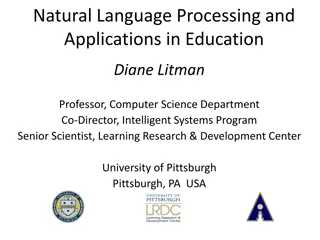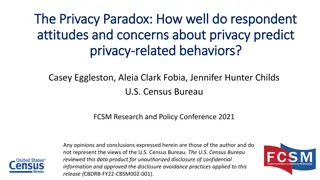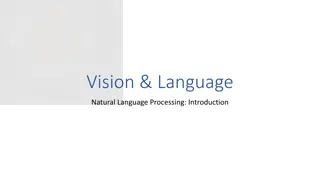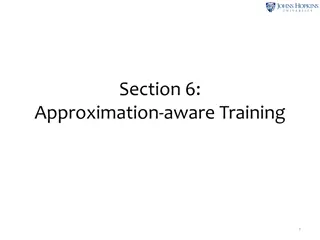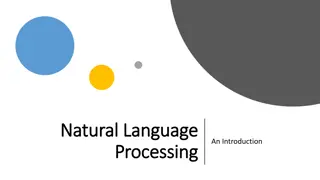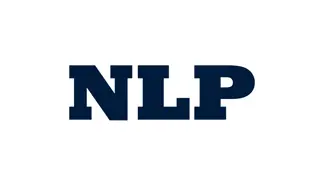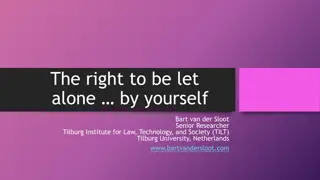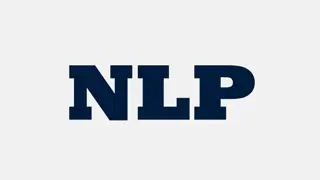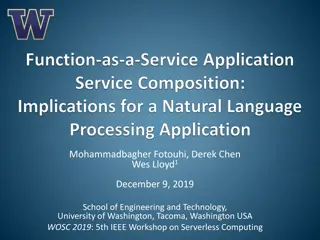Privacy-Enhancing NLP: A Comprehensive Overview
In this primer, delve into the intersection of privacy and NLP, exploring key concepts like GDPR regulations, text de-identification, synthetic text generation, and more. Understand the importance of safeguarding personal data in text documents and learn strategies to train privacy-aware NLP models effectively. Discover the nuances of anonymization under GDPR guidelines and the critical role it plays in protecting individual identities.
Download Presentation

Please find below an Image/Link to download the presentation.
The content on the website is provided AS IS for your information and personal use only. It may not be sold, licensed, or shared on other websites without obtaining consent from the author.If you encounter any issues during the download, it is possible that the publisher has removed the file from their server.
You are allowed to download the files provided on this website for personal or commercial use, subject to the condition that they are used lawfully. All files are the property of their respective owners.
The content on the website is provided AS IS for your information and personal use only. It may not be sold, licensed, or shared on other websites without obtaining consent from the author.
E N D
Presentation Transcript
Privacy-enhancing NLP: A Primer Pierre Lison Norwegian Computing Center (NR) & University of Oslo plison@nr.no Invited talk, MIKE June 30, 2023
Privacy = a fundamental human right: No one shall be subjected to arbitrary interference with his privacy, family, home or correspondence, nor to attacks upon his honour and reputation. Everyone has the right to the protection of the law against such interference or attacks. United Nations Declaration of Human Rights, 1948, Article 12 Protected through various national and international legal frameworks (such as GDPR in Europe) Common definition: ability of individuals, groups or organisations to seclude information about themselves selectively (Westin, 1967)
Privacy GDPR regulates the storage, processing and sharing of personal data = any data related to an identified or identifiable individual Personal data cannot be processed without a proper legal ground Most important ground: the consent of the individual Consent must be freely given, explicit & informed Other possible grounds: Contract, Legitimate Interest, Vital Interest, Legal Requirement, Public Interest
NLP and privacy Text documents typically contain a lot of personal information About the author of the text About the persons mentioned/described in the text 2 central questions for NLP practitioners: - How can we train more privacy-aware NLP models? - How can we use NLP to (automatically or semi- automatically) mask personal information from text?
Some key problems Text de-identification / sanitization Editing a text document to mask personal information (while retaining the rest of the content) Text obfuscation Transforming a document to conceal some sensitive demographic attributes (e.g., gender, ethnicity) Synthetic text generation Generating new documents as close as possible to the original ones (but with fictive personal data) Training of privacy-preserving NLP models Learning machine learning models or latent vector representations with privacy guarantees
Anonymisation (in the GDPR sense of the word) = Complete & irreversible removal from the data of all information that may lead (directly or indirectly) to an individual being identified But also quasi-identifiers that do not identify a person in isolation, but may do so when combined (with background knowledge): places, organisations, dates, demographic attributes, etc. Must filter out all direct identifiers: names, bank accounts, mobile phones, home addresses, social security numbers, etc
Our answer: it depends on how one interprets GPDR! Strict interpretation: no, unless the original data is deleted Risk-based interpretation: difficult, but possible 7
Anonymisation of unstructured data Main problem: requirement of unlikability with original dataset If one has access to the original data, it is quite easy to do a phrase search to find back the original document Edit operations (e.g. masking personal identifiers) Original collection of documents Search for document containing same words/phrases Anonymized version of the document 8
A simple experiment Excerpt from an actual court case from the European Court of Human Rights (ECHR), nr. 61391/00: 9
After masking direct and quasi identifiers, we obtain the following: The masking decisions are here done manually by law students at the University of Oslo 10
Is this anonymous? Combination of rejected his claim and could not be accepted also occurs once in the full dataset was advised that an appeal against appears only once in a collection of 13,759 court cases! 11
Full GDPR-compliant anonymisation: If we want to truly eliminate the risk of linkage with the original set of documents, we end up with a worthless document: 12
Text de-identification / sanitisation Difficult to truly anonymise text documents in a GDPR-compliant manner But text de-identification / sanitization still useful! Much easier to argue for a public/legitimate interest if the privacy risks are reduced, and the benefits are clear! Various de-identification techniques have been developed, both in NLP and in the field of Privacy-Preserving Data Publishing (PPDP) [Lison, P., Pil n, I., S nchez, D., Batet, M., & vrelid, L. (2021). Anonymisation models for text data: State of the art, challenges and future directions. In Proceedings of ACL 2021]
Meystre et al. (2010) Aberdeen et al., 2010) Yogarajan et al. (2018) Dernoncourt et al. (2017) Liu et al. (2017) Hartman et al. (2020) NLP methods Typically framed as a sequence labelling problem: Handcrafted patterns Neural nets + domain adaptation Largest application domain: clinical data Notably the 2014 i2b2/UTHealth shared task (diabetic patient records) & the 2016 CEGS NGRID shared task (psychiatric intake) Stubbs and Uzuner (2015), Stubbs et al. (2017)
NLP methods Limitations of sequence labelling methods: Do not remove enough: limited to a predefined list of categories Remove too much: removes all detected occurrences of those categories, regardless of disclosure risk Dependent on manually annotated data
1278 court cases from the ECHR annotated for personal information: Semantic type, masking decision, confidential attributes, co-reference relations, etc. 12 law students involved in the annotation (about 1000 hours in total!) Pil n, I et al (2022). The text anonymization benchmark (TAB): A dedicated corpus and evaluation framework for text anonymization. Computational Linguistics, 48(4), 1053-1101.
Annotation process Input: Facts section of an ECHR court case + name of person to protect in this document Step 1: Detection of personal identifiers 8 categories: PERSON, CODE, ORG, LOC, DATETIME, QUANTITY, DEM, MISC Step 2: Masking Goal: decide which text spans identified in step 1 need be masked to conceal the identity of the person to protect Assuming access to publicly available information ( the web)
Evaluation De-identification methods often rely on classical IR metrics (P/R/F1) Three problems: 1. Not all personal identifiers are equally important to mask! 2. A personal identifier is only protected if all its occurrences are masked 3. Multiple possible solutions to a given de-identification problem We present new evaluation metrics that: Distinguish between direct and indirect identifiers Operate at the level of entities, not mentions Perform a micro-average over several annotators
Evaluation Weighted precision on all identifiers Precision on all personal identifiers Recall on all personal identifiers Entity-level recall on quasi identifiers Entity-level recall on direct identifiers Fine-tuned neural language models can catch most direct identifiers, but still struggle on some quasi-identifiers (especially text spans of type DEM and MISC)
Sanitization with explicit risk measures Step 1 : privacy-enhanced entity recognition Named entity recognition + Wikidata properties associated with human individuals Step 2: privacy risk measures Neural language models + Web search High risk High risk Step 3: optimization Search for solution that keep privacy risk below a threshold, but retain as much content as possible Anthi Papadopoulou, Yunhao Yu, Pierre Lison and Lilja vrelid, Neural Text Sanitization with Explicit Measures of Privacy Risk , AACL 2022.
Some key problems Text de-identification / sanitization Editing a text document to mask personal information (while retaining the rest of the content) Text obfuscation Transforming a document to conceal some sensitive demographic attributes (e.g., gender, ethnicity) Synthetic text generation Generating new documents as close as possible to the original ones (but with fictive personal data) Training of privacy-preserving NLP models Learning machine learning models or latent vector representations with privacy guarantees
Obfuscation methods Task: conceal some sensitive personal attributes (gender, ethnicity, sexual orientation, etc.) Either from the text itself, or from latent representations derived from it Reddy and Knight (2016) Lexical substitution Elazar and Goldberg (2018) Friedrich et al (2019) Xu et al. (2019) Adversarial learning Reinforcement learning Mosallanezhad et al. (2019) Huang et al. (2020) Encryption Protection against attribute disclosure
Obfuscation methods A related problem is to conceal the identity of the author of a given text = Transform the text (or its latent representation) to prevent authorship attribution based on linguistic and stylistic properties Possible approaches: Constrain the embeddings Or add differentially-private noise [Li, Baldwin & Cohn 2018] [Fernandes et al 2019; Feyisetan et al 2019]
Text rewriting & synthesis Task: transform texts (or latent representations of those texts) to satisfy a privacy guarantee Often based on differential privacy While simultaneously seeking to preserve as much semantic quality as possible As measured by e.g. performance on downstream tasks such as classification [Xu et al, 2019, Kirshna et al, 2021, Habernal 2021, 2022]
Training NLP models Large neural language models are trained on huge amounts of text data crawled from the web along with a lot of personal data obtained without consent, and difficult to curate Those language models can be trained in a differentially private manner E.g. by adding noise to the gradients (DP-SGD) But: performance drops and large computational overheads McMahan et al (2017), Li et al (2021), Ponomareva et al (2022)
Conclusion Privacy-enhancing NLP is a rapidly growing research area At the intersection of privacy law, machine learning, NLP and data privacy Many open problems waiting to be solved! No one-size fits all : use cases design choices What kind of privacy risks do we wish to mitigate? What kind of edit operations do we allow?
